

Stadhouderlijk Hof in the city of Leeuwarden is a former residence of the Dutch royal family and was owned by them until 1971.


Stadhouderlijk Hof in the city of Leeuwarden is a former residence of the Dutch royal family and was owned by them until 1971.

The palace was originally built in 1564 by Boudewijn van Loo, the rentmaster-general of the Spanish king and leader of the Court of Friesland. In 1587 it was purchased as the residence of William Louis, Count of Nassau-Dillenburg and his wife Countess Anna of Nassau. The couple was childless and the residence passed in 1620 to Ernst Casimir, and on his death in 1632 to his eldest son Henry Casimir I of Nassau-Dietz, and then in 1640 on his death to his younger brother William Frederick, Prince of Nassau-Dietz, whose claim to fame was becoming the guardian of the future William III of England for seven years. Today he is remembered in Leeuwarden for creating the Prinsentuin garden that still exists today.
In 1672 his son Henry Casimir II, Prince of Nassau-Dietz and in 1696, his grandson John William Friso, Prince of Orange inherited the building. This string of royal names resulted in several paintings of the royal family by leading artists of the day. Many of these paintings once hung in the portrait gallery and are now spread throughout other royal collections in the Netherlands.
Since 1996 the building has become a hotel, that has preserved the 18th-century decorations as much as possible, such as the former portrait gallery redesigned in 1710 by Daniel Marot that held 17th- and 18th-century paintings by Adriaen Hanneman, Gerard van Honthorst, Lancelot Volders, Jan van Rijmsdijck and others. [1] [2]
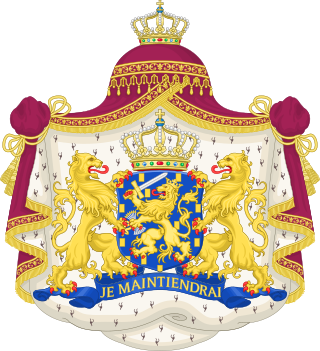
The House of Orange-Nassau is the current reigning house of the Netherlands. A branch of the European House of Nassau, the house has played a central role in the politics and government of the Netherlands and elsewhere in Europe, particularly since William the Silent organised the Dutch Revolt against Spanish rule, which after the Eighty Years' War (1568–1648) led to an independent Dutch state. William III of Orange led the resistance of the Netherlands and Europe to Louis XIV of France and orchestrated the Glorious Revolution in England that established parliamentary rule. Similarly, Queen Wilhelmina of the Netherlands was instrumental in the Dutch resistance during World War II.
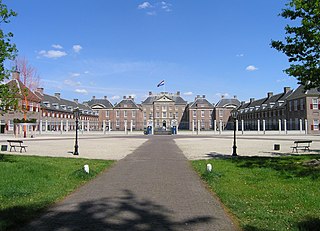
Paleis Het Loo is a palace in Apeldoorn, Netherlands, built by the House of Orange-Nassau.
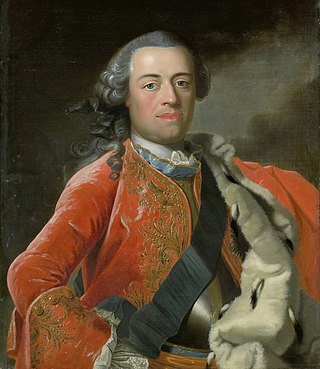
William IV was Prince of Orange from birth and the first hereditary stadtholder of all the United Provinces of the Netherlands from 1747 until his death in 1751. During his whole life he was furthermore ruler of the Principality of Orange-Nassau within the Holy Roman Empire.

Huis ten Bosch is a royal palace in The Hague, Netherlands. It is one of three official residences of the Dutch monarch; the two others being the Noordeinde Palace in The Hague and the Royal Palace of Amsterdam.
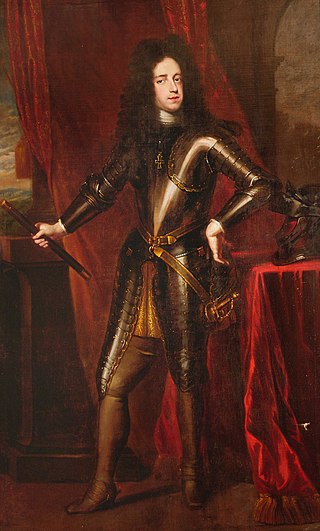
Henry Casimir II of Nassau-Dietz was Stadtholder of Friesland and Groningen from 1664 till 1696.
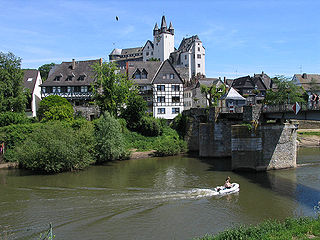
Diez an der Lahn is a town in Germany's Rhein-Lahn district in Rhineland-Palatinate, on the borders of Hesse. Diez is the administrative seat of the municipality of Diez.

Tethart Philipp Christian Haag was a Dutch artist and court painter to William V of Orange-Nassau and the director of cultural institutions in The Hague.

Albertine Agnes of Nassau, was the regent of Friesland, Groningen and Drenthe during the minority of her son Henry Casimir II, Count of Nassau-Dietz, between 1664 and 1679. She was the sixth child and fifth daughter of stadtholder Frederick Henry, Prince of Orange and Amalia of Solms-Braunfels.

Adriaen Hanneman was a Dutch Golden Age painter best known for his portraits of the exiled British royal court. His style was strongly influenced by his contemporary, Anthony van Dyck.

William Frederick, was Count of Nassau-Dietz, Stadtholder of Friesland, Groningen and Drenthe.

Henry Casimir I of Nassau-Dietz was count of Nassau-Dietz and Stadtholder of Friesland, Groningen and Drenthe.

Philip van Dijk was an 18th-century painter from the Dutch Republic.

Princess Sophie Amalie of Nassau-Siegen, German: Sophia Amalia Prinzessin von Nassau-Siegen, official titles: Prinzessin von Nassau, Gräfin zu Katzenelnbogen, Vianden, Diez, Limburg und Bronkhorst, Frau zu Beilstein, Stirum, Wisch, Borculo, Lichtenvoorde und Wildenborch, Erbbannerfrau des Herzogtums Geldern und der Grafschaft Zutphen, was a countess from the House of Nassau-Siegen, a cadet branch of the Ottonian Line of the House of Nassau. In 1664, she was elevated to the rank and title of princess. By marriage she became Duchess Consort of Courland.

Juriaen Jacobsz, also known as Georg Albert Jacobsz, was a Dutch Golden Age portrait and animal painter. He was a pupil of Frans Snyders in Antwerp and a teacher of Hendrik Carré in Leeuwarden. In Leeuwarden he became court painter to Henry Casimir II, Prince of Nassau-Dietz. According to the Netherlands Institute for Art History, he was in Antwerp from 1652 to 1658, in Amsterdam from 1659 to 1664, then travelled to Leeuwarden in 1665, where he stayed. His pupils were Hendrik Carré and David Klöcker Ehrenstrahl.

Lancelot Volders also erroneously known as Louis Volders, Lois Volders and Jan Volders was a Flemish painter who specialised mainly in individual and group portraits but also produced a few history paintings and genre scenes. After training and working in Brussels, he may have worked after about 1700 from time to time at the Stadhouderlijk Hof in Leeuwarden.
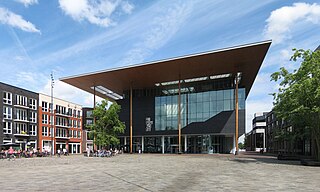
The Fries Museum is a museum in Leeuwarden, Netherlands. It has won the Global Fine Art Award which is sometimes nicknamed the Museum-Oscar.

Prince Frederick William Adolf of Nassau-Siegen, German: Friedrich Wilhelm Adolf Fürst von Nassau-Siegen, official titles: Fürst zu Nassau, Graf zu Katzenelnbogen, Vianden, Diez, Limburg und Bronkhorst, Herr zu Beilstein, Stirum, Wisch, Borculo, Lichtenvoorde und Wildenborch, Erbbannerherr des Herzogtums Geldern und der Grafschaft Zutphen, was since 1691 Fürst of Nassau-Siegen, a part of the County of Nassau. He descended from the House of Nassau-Siegen, a cadet branch of the Ottonian Line of the House of Nassau.

The Prince William V Gallery is an art gallery on the Buitenhof in The Hague that currently shares an entrance with the Gevangenpoort museum. It is a recreation of the original gallery Galerij Prins Willem V, once founded there by William V, Prince of Orange in 1774. The displayed paintings are part of the collection of the Mauritshuis. Amongst the paintings on display are works by Peter Paul Rubens, Jan Steen, Paulus Potter and Gerard van Honthorst.

Grote of Jacobijnerkerk is a Protestant church in the city of Leeuwarden, Netherlands. The square surrounding the church is the Jacobijnerkerkhof.

Nassau Palace was the former city palace of the House of Orange in Brussels. The palace was constructed in the 14th century and expanded in the following centuries. In the 18th century, it was acquired by Governor of the Habsburg Netherlands, Prince Charles Alexander of Lorraine, who replaced it with the Palace of Charles of Lorraine. Today, nothing remains except the chapel, which is part of the building of the Royal Library of Belgium (KBR).